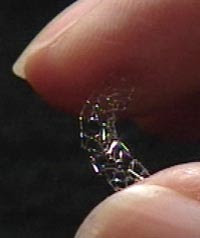Schofer, Schluter, Gershlick et al. “Sirolimus-eluting stents for treatment of patients with long atherosclerotic lesions in small coronary arteries: double-blind, randomized controlled trial.” Lancet. 362. October 2 (2003): 1093-1099. Print.
http://www.sciencedirect.com/science?_ob=ArticleURL&_udi=B6T1B-49NV339-7&_user=489286&_rdoc=1&_fmt=&_orig=search&_sort=d&_docanchor=&view=c&_searchStrId=1121247921&_rerunOrigin=scholar.google&_acct=C000022678&_version=1&_urlVersion=0&_userid=489286&md5=3c4c00a33c12270374d606039ea7a222
This article from Lancet provides more information about the Sirolimus-eluting stent. The previous article proves that Sirolimus-elutin stents are more effective than a bare metal-stents in preventing neointimal hyperplasia. This study helps confirm this belief.
Schofer and his colleagues in Germany went further in depth and examined patients with higher risk profiles for restenosis. This higher risk group included patients with previous myocardial infarction (42%) and current smokers (33%). They often tended to have small mean reference vessel diameter and long average lesion length, both of which predispose to restenosis. 352 patients were enrolled in this study, with vessel diameters ranging from 2.5-3 mm and lesion length from 15-32 mm. Two groups were compared, a sirolimus-eluting stent group (n=175) and a bare-metal stent group (control, n=177). The researchers examined the difference in lumen diameter after 8 months and whether patients had major adverse cardiac events at 9 months. It was a double blind study and randomized to allow for an effective examination of the two groups.
This trial concluded that sirolimus-eluting stents are more effective than the typical bare-metal stent. After 8 months, the control group had a significantly higher lumen diameter than the sirolimus-eluting group (2.22 vs 1.33). The sirolimus-eluting group also had significantly lower adverse cardiac events (8% vs 22.6%) and a lower need for target-lesion revascularizations. This study shows that for every 1000 patients undergoing stent implantation, with sirolimus-eluting stents, about 170 will be spared a repeat procedure.


No comments:
Post a Comment